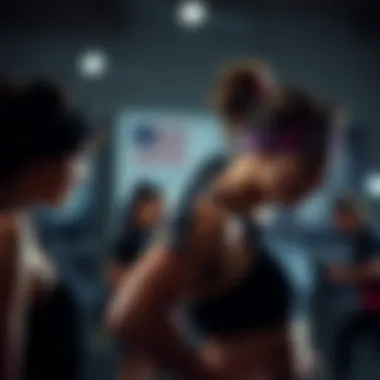The Importance of Sweat Bands in Modern Fitness


Intro
In the realm of modern fitness, the equipment we choose plays a pivotal role not only in enhancing performance but also in reflecting personal style. Among these accessories, workout sweat bands have carved a niche that balances functionality with a touch of flair. No longer just a simple tool for soaking up sweat, these bands embody a blend of aesthetics, practicality, and individual expression. They come in various colors and designs, appealing to both the fitness fanatic and the style-conscious individual. As we delve deeper, we'll uncover the multifaceted role sweat bands play in today's fitness culture, highlighting their evolution from utilitarian items to fashion statements.
Fashion Trends
Current Styles and Influences
The world of workout wear has seen a remarkable shift over the past few years. Sweat bands are no longer confined to the traditional and rather plain designs; they have transformed into vibrant and imaginative accessories. Brands such as Nike and Lululemon are pushing boundaries with designs that mix bold colors, patterns, and innovative materials. Athletes and fitness enthusiasts often incorporate these accessories into their looks, aligning personal branding with professional performance.
- Elastic Bands: Often favored for their stretchability, these bands provide a snug fit during workouts without slipping down.
- Silicone Options: Waterproof and designed for durability, silicone sweat bands are popular for those who tend to engage in high-intensity activities.
- Fashion Collaborations: Collaborations with lifestyle brands are on the rise, leading to unique collections that appeal to both fitness lovers and fashion enthusiasts.
The influence of social media cannot be overlooked. Platforms like Instagram and Pinterest showcase an array of styles, allowing users to discover new trends and incorporate them into their wardrobes. Influencers often share their workout routines adorned with stylish sweat bands, contributing to the demand and popularity of these accessories.
Forecasting Future Trends
As we look ahead, one can predict that the trend of fashionable workout sweat bands will continue to gain momentum. Sustainability concerns are poised to impact material choices significantly. More brands are likely to embrace eco-friendly fabrics that still deliver performance while appealing to a conscious consumer base.
Furthermore, technology convergence with wearables could lead to smart sweat bands equipped with sensors to track performance metrics, integrating fitness seamlessly into style. The advent of customizable features—where users can choose colors, materials, and designs—seems like a natural next step in this evolving market. The blending of comfort and performance with personalized style will likely define future offerings in this realm.
Wardrobe Essentials
Building a Versatile Closet
Creating a versatile gym wardrobe is essential for both functionality and style. Sweat bands, among other accessories, play a pivotal role in promoting an effective workout routine. Investing in a few high-quality pieces can expand workout options and improve personal branding in fitness spaces.
- Neutral Colors: Starting with versatile hues like black, navy, and gray can help in mixing and matching various workout outfits effectively.
- Layering Pieces: Consider including tank tops, long-sleeve shirts, and lightweight jackets that can be layered with sweat bands for a cohesive look.
Key Pieces for Every Season
Adjusting your workout gear according to the seasons can enhance both style and comfort.
- Summer: Lightweight, breathable materials are key. Pair vibrant sweat bands with sleeveless tops and shorts.
- Winter: Opt for thicker, moisture-wicking sweat bands that pair well with long-sleeve tops and full leggings.
Incorporating workout sweat bands into various outfits can transition easily from gym sessions to daily activities, creating a coherent and stylish image. They not only assist in maintaining focus during workouts by managing sweat but also allow for personal expression through diverse designs.
"Sweat bands serve as both a practical tool and a statement of personal style in the fitness world."
Culmination
In summary, workout sweat bands are much more than mere accessories. They encapsulate a fusion of functionality and fashion within the fitness culture. Understanding their evolution, styles, and role is essential for anyone looking to navigate the contemporary world of fitness with flair. As trends continue to shift, it remains crucial for consumers and brands alike to consider the impact of these unique pieces on performance, personal branding, and overall workout experience.
For further insights into fashion and fitness, you can refer to Wikipedia and Britannica. Explore discussions on related topics on Reddit and connect with communities on Facebook.
Preamble to Workout Sweat Bands
In today’s fast-paced world, where fitness is not merely a trend but rather a lifestyle choice, workout sweat bands have carved out a unique niche. They might seem like an afterthought to many, yet they hold a rather significant position in the fitness realm. Sweat bands aren’t just about catching perspiration; they’re about performance, style, and even identity. There’s a lot more to them than meets the eye.
Defining Sweat Bands
So, what exactly are sweat bands? In essence, they are elastic bands made of absorbent materials, typically worn around the wrists or forehead during physical activities. Their primary role is to manage moisture, helping to keep sweat out of the eyes and off the hands. This simple yet effective function can greatly enhance focus and comfort during workouts. Just imagine hitting the gym and having your vision blurred from sweat trickling down your forehead—it’s not an ideal scenario.
Moreover, sweat bands come in various designs, colors, and materials, catering to diverse preferences and needs. From high-tech, moisture-wicking fabrics to classic cotton variants, the choices are plentiful. Some bands feature additional functionalities, such as pockets for storing small items or built-in cooling technology, merging practicality with innovation. The variety available today tailors these accessories to modern fitness enthusiasts who prioritize both function and style in their workout gear.
The Historical Context
To truly appreciate the role of sweat bands in contemporary fitness, one must take a step back in time. The concept of wearing something to soak up sweat dates back to ancient cultures. Early athletes used cloth strips or leather bands to protect themselves as they engaged in rigorous training or competition. Fast forward to the 1980s, and we see sweat bands exploding in popularity, largely due to aerobics and the fitness boom. Famous figures like Richard Simmons and Jane Fonda sported them, making them a symbol of an energetic workout culture.
Over the decades, sweat bands evolved—both in design and purpose. Initially associated with amateur athletes, they've transformed into staple attire for professionals, celebrities, and everyday fitness enthusiasts alike. Often featured in advertisements for various fitness programs and athletic clothing lines, sweat bands today carry a certain cachet, bridging the gap between practicality and fashion.


"As fitness has evolved, so has the image of what workout gear should represent. Sweat bands exemplify how functional items can also become fashionable statements."
In summary, far from just being bland pieces of fabric, workout sweat bands manifest the evolution of fitness culture. They have emerged, not only as functional tools but also as reflections of personal style and fitness identity. Understanding their significance not only sheds light on their utility but also on their place within the broader narrative of fitness and fashion.
Functionality and Performance
The functional aspects of workout sweat bands resonate with fitness enthusiasts and casual gym-goers alike. These seemingly simple accessories serve multiple purposes, each contributing significantly to an effective workout experience. From moisture management to providing a secure grip, sweat bands elevate both performance and comfort, making them salient to the modern fitness narrative.
Moisture Management
One of the primary benefits of workout sweat bands is their role in moisture management. When engaged in high-intensity exercises, the body naturally produces sweat. Sweat bands, typically fashioned from absorbent materials, act as barriers, capturing sweat before it can drip down into the eyes or onto equipment. This can prevent distractions, allowing individuals to maintain focus during their workout.
Moreover, effective moisture management can reduce the risk of chafing and discomfort, enabling longer training sessions without the nagging annoyance of perspiration running into one’s face.
- Key Benefits of Moisture Management:
- Keeps sweat away from the eyes, improving visibility.
- Minimizes skin irritations caused by sweating.
- Enhances comfort, allowing for prolonged workouts.
This leads to the fundamental truth that staying dry can enhance performance, a reality that many might overlook. The right workout sweat band can mean the difference between a lackluster session and one that feels productive and invigorating.
Improved Grip and Control
Workout sweat bands also contribute significantly to grip and control. During exercises that require a steadfast grasp—like weightlifting or pull-ups—sweat can make hands slippery. A sweat band acts as an added layer of friction, helping to wick moisture away from the palms.
Consider this: without proper grip, heavy weights can become unwieldy, and chances of injury rise. Hence, by using a sweat band, lifters can feel a sense of security, thereby enhancing their performance.
- Essentials of Improved Grip and Control:
- Enhances stabilization during lifts and maneuvers.
- Reduces the risk of dropping weights due to sweat.
- Provides a more confident workout experience.
Grip is crucial, and investing in a good quality sweat band contributes toward achieving those important reps without compromising safety.
Injury Prevention
Another less obvious yet crucial role of sweat bands stems from their potential for injury prevention. Exercise, while beneficial, often leads to strains or injuries if not executed correctly. Sweat bands can be instrumental in providing extra support to wrist and forearm areas during demanding workouts. For instance, a wrist support band can bolster alignment and provide stability, reducing the likelihood of sprains.
Additionally, they serve as a reminder to maintain proper form. When wearing a sweat band, the added tension or snug fit can subtly cue the athlete to remain focused and intentional in their movements, fostering a more mindful workout approach.
- Key Aspects of Injury Prevention:
- Provides extra reinforcement to vulnerable joints.
- Deters injuries through better focus and body awareness.
- Serves as a stylish accessory that reminds users of safety.
In summary, sweat bands are not merely about keeping clothes dry. They enhance performance through moisture management, improve grip and control, and play a role in preventing injuries. Understanding these functionalities equips individuals in making informed choices about their workout gear, melding utility with an effective fitness routine.
Material Composition of Sweat Bands
The material composition of workout sweat bands is pivotal in understanding their utility and performance enhancement in fitness routines. The choice of fabric not only affects comfort and durability but also significantly influences the functional properties of these accessories. When selecting a sweat band, one must consider factors like breathability, moisture-wicking abilities, and elasticity. Each of these elements contribute to the overall effectiveness of the band during physical activities, ensuring that athletes and fitness enthusiasts can perform at their best.
Common Fabrics Used
There’s a variety of fabrics that make up workout sweat bands. Knowing them can help set one apart when making a purchasing decision.
- Cotton: While it’s soft and comfortable, cotton holds onto moisture. This can lead to a heavy and soggy band during intense workouts.
- Polyester: Commonly used, polyester is durable and lightweight. It tends to dry out fast, making it a preferred choice for athletes.
- Nylon: This material is well-regarded for its strength and abrasion resistance. Nylon sweat bands often have a smooth finish that feels good against the skin.
- Spandex: Known for its stretchability, spandex provides snug fit while allowing for a full range of motion. It’s usually blended with other fabrics for enhanced performance.
- Microfiber: Often recognized for its moisture-wicking capabilities, microfiber bands can effectively draw sweat away from the skin.
In summary, while cotton may feel cozy, investing in a sweat band made from synthetic blends can yield better results in performance.
Decoding Moisture-Wicking Technology
Now, let’s delve into that trendy buzzword - moisture-wicking technology. This term often swirls around in fitness circles, hinting at the allure of staying dry during workouts. But what exactly does it mean?
Moisture-wicking fabrics are engineered to move sweat away from the body and onto the surface of the garment, allowing for quick evaporation. This process involves a combination of hydrophilic (water-attracting) and hydrophobic (water-repelling) fibers.


"Effective moisture-wicking technology plays a crucial role in keeping athletes comfortable and focused, minimizing distractions during their routines."
For, instance, the inner layer of a sweat band might be made from a hydrophilic material that pulls sweat away, while the outer surface is hydrophobic, boosting the evaporation process.
When choosing a workout sweat band, it’s wise to look for those that boast this kind of technology. The bands that feature such fabrics tend to keep the wearer dry, improving both comfort and performance. Ultimately, having a well-made sweat band can be the difference between a regular workout and one that feels seamless and enjoyable.
Links for further reading:
The Intersection of Fashion and Function
In today’s fitness landscape, sweat bands have transcended their original purpose, morphing into essential fashion accessories that are as stylish as they are practical. Understanding this intersection of fashion and function can elevate the perspective on how such seemingly simple items contribute to the larger narrative of personal fitness and style.
Emergence of Stylish Designs
Gone are the days when sweat bands existed purely as utilitarian objects. Now, they showcase a variety of designs that cater not only to style but also to personal expression. From vibrant colors to unique patterns, today’s workout sweat bands are tailored to suit diverse tastes. Brands like Lululemon and Nike offer models that incorporate trendy prints and innovative cuts, appealing to a broad audience.
This shift towards aesthetics reflects a cultural change within the fitness community. With the rise of social media, enthusiasts often showcase their workouts and outfits online. It has become increasingly common for individuals to curate their fitness wardrobes, presenting a polished look in addition to a solid workout ethic. This phenomenon has led to creative collaborations between fitness brands and fashion designers. Such collaborations are not only about reinvigorating the product but also proving that function can go hand-in-hand with elegance.
Brand Collaborations and Endorsements
The growing synergy between fashion labels and fitness brands highlights the importance of branding in modern fitness contexts. Collaborations, such as those between Adidas and fashion designer Stella McCartney, push the boundaries of traditional workout gear, allowing for striking designs matched with high performance. This blending of fashion-forward thinking with workout necessity amplifies desirability among consumers who seek out products that embody both style and effectiveness.
Endorsements from high-profile athletes and fashion icons reinforce this trend, creating a powerful influence on consumer choices. When someone like Serena Williams sports a chic sweat band, it invariably shifts public perception, elevating the accessory from a mere exercise tool to a coveted fashion item. Such visibility not only drives sales but also engages a community that values both performance and appearance.
"In the realm of fitness, what we wear can motivate us as much as the routines we follow."
This interplay of stylish designs, brand collaborations, and endorsements reshapes how we view sweat bands overall. Increasingly, they are perceived not just as a functional piece of workout gear but as an integral part of one’s personal identity in the fitness domain. This evolution signifies a deeper understanding of fitness culture, where aesthetics matter just as much as athletic performance.
Cultural Significance of Sweat Bands
In modern fitness culture, sweat bands extend beyond mere functional accessories; they are emblematic of identity and community. Their cultural significance is deeply rooted in how they represent dedication and informal commitment to fitness lifestyles. Let’s peel back the layers of this phenomenon.
Symbolism in Fitness Communities
Sweat bands have morphed into a symbol of perseverance within fitness communities. Members often wear them not just for utility but to communicate that they are part of a collective striving towards health and achievement. In many exercise environments—from casual gyms to professional fitness competitions—wearing a sweat band indicates that one is ready to put in the work.
For some, it’s a badge of honor. When I observe a group workout class, the sight of vibrant sweat bands seems to create an unspoken bond among participants. A common sight is someone proudly donning a bright neon band, signaling their zeal and determination to push through any physical hurdle. It's more than just fabric; it’s a conversation starter and a source of communal strength.
"Wearing a sweat band is like donning armor for the battle against physical limits."
Additionally, these accessories cultivate an image of aspirational fitness—a portrayal often embraced in social media feeds, where influencers showcase not just exercises but their entire lifestyle. The aesthetics of sweat bands complement athletic wear, contributing to a distinct look that is both stylish and functional. This connection between design and personal expression adds to their symbolic value, reinforcing a shared narrative among fitness enthusiasts.
Influence on Personal Branding
On platforms like Instagram, sweat bands serve as essential tools of personal branding. Fitness influencers and bloggers use them not just as part of their gear but as components of their identity. A cleverly chosen sweat band aligns with their visual storytelling, helping to establish brand recognition in a saturated market. Think about it—when you see a familiar fitness personality wearing a specific brand of sweat band, you automatically associate it with their unique style and message.
In personal interactions, it educates how someone approaches fitness. A person rocking a simple cotton band may communicate a different vibe than someone sporting a high-tech, sleek model. The same sweat band that absorbs moisture can also encapsulate lifestyle choices, turning what might seem incidental into integral parts of an overarching brand message.
When influencers endorse specific bands, they often inspire their audience to imitate not just the look but also the attitude. The workout sweat band can serve as a bridge, connecting individual styles with broader fitness aspirations. It elevates their persona, allowing followers to envision personal fitness journeys aligned with those they admire.
In closing, the cultural significance of sweat bands transcends their functionality. They become part of a larger social narrative that influences how we perceive fitness, identity, and community engagement. As more people dive into fitness routines, these bands are likely to further solidify their role as symbols of both personal commitment and collective motivation.
Choosing the Right Sweat Band
Choosing the right sweat band is not just a matter of preference; it can significantly influence your workout experience and outcomes. The market today offers a multitude of options, catering to diverse needs and styles. All these choices can be overwhelming, yet picking the right one is crucial for maximizing both functionality and comfort. So, how does one discern the best fit?
Considerations for Active Lifestyles


When selecting a sweat band, one must first reflect on their active lifestyle. Different activities demand unique features in a sweat band. For example:
- High-intensity workouts: Those participating in vigorous activities like CrossFit or boot camps may need sweat bands that offer superior moisture management and stay securely in place. Bands that use advanced moisture-wicking materials are essential here.
- Yoga or pilates: If you lean towards gentler exercises, a softer band that provides minimal distraction and flexible fit is ideal.
- Casual jogging: A lightweight, breathable option that can keep hair and sweat at bay is often sufficient for this activity.
Also, consider the climate in which you exercise. In warmer regions, a lightweight material that allows ventilation may be a priority, while in cooler areas, comfort and thermal retention could be more significant. Furthermore, how often you plan to wash the band can influence your choice, particularly if you’re using it regularly.
Fit and Comfort Factors
Ultimately, the fit and comfort of the sweat band are paramount. A band that feels bulky or tight can be quite detrimental to your focus and performance. Here are a few points to ponder when selecting:
- Sizing: Many brands offer products in multiple sizes; don’t hesitate to measure your head circumference if you're unsure. A tight fit can pinch, while a loose fit may slide down during use.
- Material: Elasticity and breathability are crucial factors. Bands made from cotton may absorb sweat well but can become heavy and uncomfortable. Alternatively, polyester blends or specialized fabrics like Coolmax might provide better moisture control and quick drying.
- Design: Some sweat bands come with additional features such as silicone grips, which help keep them in place. Others might be reversible or feature stylish designs, allowing them to double as headbands off the gym floor.
Choosing the right sweat band is a blend of personal preference and practical necessity. It’s about finding that sweet spot between aesthetics and function, ensuring your workout is as seamless as possible.
"The right gear can turn a good workout into a great one; don’t underestimate the power of the right sweat band."
Care and Maintenance of Sweat Bands
Caring for your workout sweat bands is not just a chore; it's a crucial aspect that can extend the life and performance of these accessories significantly. When you put on that sweat band, it’s more than a mere accessory; it’s a partner in your workout journey. Thus, proper maintenance not only ensures hygiene but also helps keep them in top-notch condition, enabling them to perform their duty effectively.
A well-maintained sweat band can absorb moisture better, maintain its elasticity, and provide that snug fit while you’re lifting weights or doing cardio. Moreover, regular care avoids the build-up of bacteria and odors, which is particularly important for something worn close to the skin. Here are some specific elements of care and maintenance that will serve you well:
- Hygiene: Dirty sweat bands can lead to skin irritations and breakouts. Regular washing helps in keeping those potential problems at bay.
- Durability: Sweat bands crafted from high-quality materials are made to last, but neglect can lead to deterioration, shortening their lifespan.
- Performance: The absorption and moisture-wicking qualities decrease when sweat bands aren’t cleaned regularly. Keeping them fresh ensures they do the job they were designed for.
Cleaning Techniques
Cleaning your sweat bands can be a straightforward task if you follow the right techniques. Here’s how to keep them in pristine shape:
- Machine Wash: Most modern sweat bands can withstand machine washing. Use a gentle cycle with cold water to avoid shrinking.
- Hand Wash: If you prefer a more delicate approach, hand washing in warm water with mild detergent works wonders. Gently rub the fabric to remove any stubborn stains.
- Avoid Fabric Softener: It’s tempting to toss in that fresh-scented fabric softener, but resist the urge. Softener can coat the fibers, reducing their moisture-wicking capabilities.
- Air Dry: Always opt for air drying instead of tumble drying. High heat can cause the elastic fibers to degrade over time.
Remember that washing them right after your workout can prevent odors and stains from setting in. Ideally wash them weekly, or more often if you’re a frequent gym-goer.
Longevity Tips
If you want your workout sweat bands to last as long as a marathon runner’s spirit, here are a few simple tips to help:
- Rotate Your Bands: If you have multiple sweat bands, don’t wear the same one every day. Rotating them allows each band time to recover.
- Store Properly: Avoid cramming them in gym bags. Instead, store them in a cool, dry place to maintain elasticity and shape.
- Avoid Excessive Stretching: Many users tend to stretch their bands excessively during workouts. Keep stretches to a minimum to preserve their original shape and snugness.
- Check for Wear: Regularly inspect your sweat bands for any signs of wear and tear. If you notice any holes or loose stitches, it may be time to retire that band.
Caring for your workout sweat bands goes beyond mere practicality. It’s an investment in your fitness experience. Much like any tool, proper care leads to better performance and a longer lifespan, allowing you to focus on what really matters – your workout.
"The right care can transform your sweat band from a disposable item into a long-lasting companion in your fitness journey."
Links:
- To learn more about fabric care: Britannica
- For tips on maintaining workout gear: Reddit Fitness Community
Future Trends in Sweat Bands
As the fitness landscape continuously evolves, so too does the role of accessories like sweat bands. Their function has transcended mere utility, integrating into the very fabric of modern fitness culture. An understanding of future trends in sweat bands is pivotal not only for enthusiasts but also for brands aiming to stay ahead in an ever-competitive market.
Innovations in Design and Function
Today’s workout sweat bands are becoming much more than a tool for absorbing perspiration. Cutting-edge designs incorporate advanced materials that enhance performance. For instance, brands are experimenting with synthetic fabrics that not only wick moisture away but also offer antimicrobial properties. This innovation addresses the common complaint of odor retention, ensuring that users feel fresh even during intense workouts.
Moreover, technological incorporations are making waves. Imagine sweat bands equipped with sensors that monitor sweat rates or track temperature. Such features could provide real-time feedback, empowering users to adjust their routines accordingly. While the average consumer may still associate sweat bands with simple functions, fitness tech enthusiasts are looking for multifaceted tools that offer more than just basic utility. Their future is brightly colored with opportunities to elevate both comfort and efficiency in workouts.
Sustainability Efforts
In a world increasingly focused on sustainability, the fitness accessory market is no exception. With environmental concerns at the forefront of consumer preferences, many brands are pivoting toward eco-friendly materials. Consumers today are not only searching for high-performance products but also evaluating the ethical implications of their purchases.
Some companies are utilizing recycled polyester from plastic bottles, effectively reducing waste while creating durable products. Cotton alternatives like organic cotton, which is produced without harmful pesticides, are also gaining traction in the market. This shift reflects a larger narrative about responsible consumption, showing that functional fitness gear can also be planet-friendly.
Furthermore, innovative production methods that minimize water use and carbon footprints are coming into play. As more brands adopt these sustainable practices, consumers can feel good about their purchases, knowing they are supporting a healthier planet.
"Shifting toward sustainability doesn't mean sacrificing function for style. It’s about creating a balance that resonates with modern consumers."
These trends encapsulate a transformative moment not just for sweat bands but the entire fitness industry. As innovations emerge and sustainability becomes a priority, the role of workout sweat bands will undoubtedly evolve, staying relevant in a space where both utility and ethical considerations matter.



